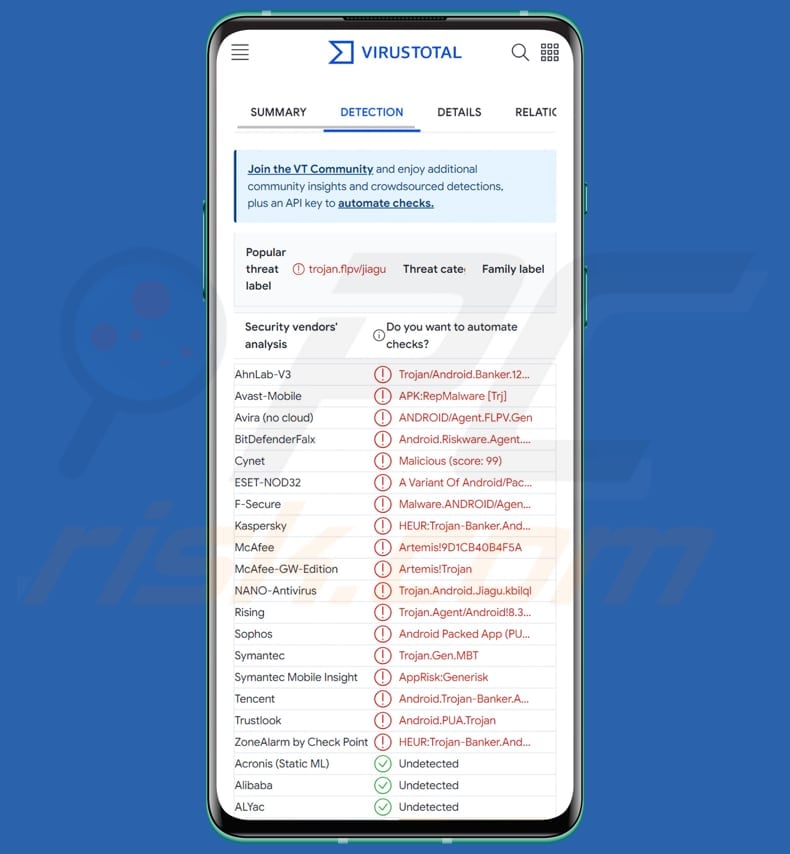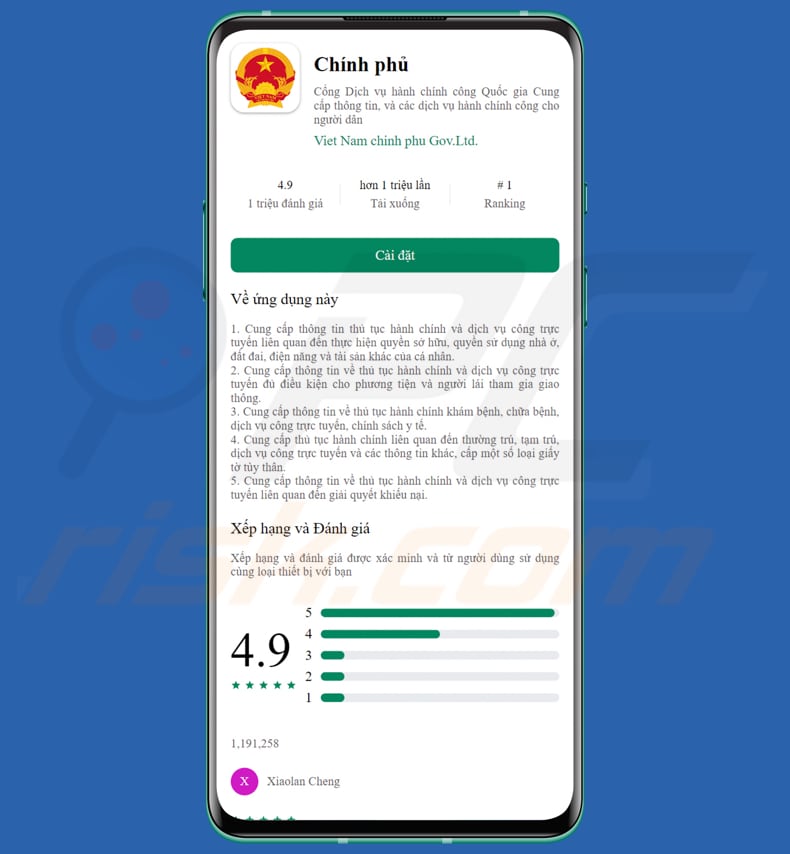How to remove GoldDigger malware from infected Android devices
TrojanAlso Known As: GoldDigger Android malware
Get free scan and check if your device is infected.
Remove it nowTo use full-featured product, you have to purchase a license for Combo Cleaner. Seven days free trial available. Combo Cleaner is owned and operated by RCS LT, the parent company of PCRisk.com.
What kind of malware is GoldDigger?
GoldDigger is an Android Trojan with a focus on financial institutions, having been operational since at least June 2023. This Trojan camouflages itself as a counterfeit Android app, capable of mimicking both a Vietnamese government portal and a local energy firm, all with the primary objective of pilfering banking credentials.

GoldDigger in detail
GoldDigger abuses Android's accessibility services to interact with targeted apps, extracting personal information, stealing banking credentials, logging keystrokes, capturing 2FA codes, intercepting SMS messages, and more. The attack chain relies on fake websites that mimic Google Play Store pages and Vietnamese corporate sites, potentially distributed through phishing tactics.
GoldDigger employs an advanced protection mechanism, Virbox Protector, to evade detection and analysis, making it challenging to trigger malicious activity in sandboxes or emulators. GoldDigger also manipulates Accessibility Service to gain control over user actions, potentially allowing remote access to the victim's device.
It monitors and extracts data from 51 financial apps, e-wallets, and crypto apps in Vietnam, sending it to command-and-control servers. While the full extent of its capabilities is not confirmed, it poses significant risks, including authentication bypass and remote access.
Possible damage
GoldDigger's primary goal is to harvest banking credentials, allowing cybercriminals to access victims' financial accounts, make unauthorized transactions, and potentially drain funds.
By intercepting SMS messages, the trojan can capture one-time passwords (OTP) or two-factor authentication (2FA) codes sent by banks for additional security, enabling attackers to bypass these security measures.
Also, GoldDigger has the capability to log keystrokes, which means it can record usernames, passwords, and other sensitive information entered by the victim, further compromising their security.
Through its manipulation of Accessibility Service, GoldDigger can establish a backdoor into the victim's device, allowing cybercriminals to remotely access and control the compromised device, potentially for further malicious activities.
| Name | GoldDigger Android malware |
| Threat Type | Android Trojan |
| Detection Names | Avast-Mobile (APK:RepMalware [Trj]), Combo Cleaner (Android.Riskware.Agent.KPE), ESET-NOD32 (A Variant Of Android/Packed.Jiagu.K Potentially Unsafe), Kaspersky (HEUR:Trojan-Banker.AndroidOS.Agent.lu), Full List (VirusTotal) |
| Related Domains | cgovn[.]cc, egovn[.]cc, evnspa[.]cc, evnspc[.]cc, evnspe[.]cc, evnspo[.]cc, evnspr[.]cc, gdtgovn[.]com, govn[.]cc, vietcp[.]cc, vietgav[.]cc, vietgov[.]cc, vietgov0[.]cc, vietgov1[.]cc, vietgov22[.]cc, vietgov3[.]cc, vietgov33[.]cc, vietgov4[.]cc, vietgov5[.]cc, vietgov6[.]cc, vietgovn[.]cc, viettgov[.]cc, vitgov[.]cc. |
| Symptoms | The device is running slow, system settings are modified without user's permission, questionable applications appear, data and battery usage is increased significantly, browsers redirect to questionable websites, intrusive advertisements are delivered. |
| Distribution methods | Deceptive websites (mostly fake Google Play sites), SMS phishing, fraudulent emails, malicious online advertisements, social engineering, deceptive applications. |
| Damage | Stolen personal information (private messages, logins/passwords, etc.), decreased device performance, battery is drained quickly, decreased Internet speed, huge data losses, monetary losses, stolen identity, and more. |
| Malware Removal (Windows) |
To eliminate possible malware infections, scan your computer with legitimate antivirus software. Our security researchers recommend using Combo Cleaner. Download Combo CleanerTo use full-featured product, you have to purchase a license for Combo Cleaner. 7 days free trial available. Combo Cleaner is owned and operated by RCS LT, the parent company of PCRisk.com. |
Conclusion
In conclusion, GoldDigger represents a highly sophisticated and dangerous Android Trojan targeting financial organizations, primarily in Vietnam. As GoldDigger's capabilities and reach expand, it is crucial for organizations and individuals to remain vigilant and employ robust cybersecurity practices to mitigate the risks posed by this malicious Android Trojan and similar threats in the ever-evolving threat landscape.
Examples of other Trojans targeting Android devices are Remo, Fleckpe, and KEYSTEAL.
How did GoldDigger infiltrate my device?
GoldDigger's distribution method relies on deceptive websites that impersonate legitimate sources, primarily masquerading as Google Play pages and corporate websites within Vietnam. To propagate the malware, the Trojan operators are believed to employ techniques like smishing (SMS phishing) or traditional phishing to disseminate links to these fraudulent websites.
Within these malicious websites, users are presented with enticing download links for Android applications. These applications are, in fact, malicious APKs designed to infect the victim's device with GoldDigger.
It is important to note that all Android devices have a security feature known as "Install from Unknown Sources" disabled by default. This feature is intended to prevent the installation of apps from sources outside of the Google Play Store, where apps are usually vetted for security.
However, GoldDigger's successful installation depends on a critical factor: the victim's device must have the "Install from Unknown Sources" setting enabled. If this setting is activated, it allows the installation of apps from sources other than the official Google Play Store. This setting becomes a gateway for GoldDigger to infiltrate devices.
How to avoid installation of malware?
Download apps only from official sources like the Google Play Store. Avoid third-party app stores or sideloading apps from unknown websites, as these are more likely to contain malware. Pay attention to app permissions. Only grant apps the permissions they genuinely need. Regularly update your Android operating system and apps.
Be cautious when clicking links in emails, text messages, or pop-up ads. Verify the source and authenticity of the message before taking any action. Consider installing reputable antivirus or anti-malware apps from trusted developers.
Appearance of websites (evnspa[.]cc; evnspc[.]cc; evnspe[.]cc; evnspo[.]cc; evnspr[.]cc) used to spread GoldDigger trojan:

Appearance of other malicious websites (gdtgovn[.]com; ugovn[.]cc; vietcp[.]cc; vietgov6[.]cc; vitgov[.]cc) used to spread GoldDigger trojan:

Quick menu:
- Introduction
- How to delete browsing history from the Chrome web browser?
- How to disable browser notifications in the Chrome web browser?
- How to reset the Chrome web browser?
- How to delete browsing history from the Firefox web browser?
- How to disable browser notifications in the Firefox web browser?
- How to reset the Firefox web browser?
- How to uninstall potentially unwanted and/or malicious applications?
- How to boot the Android device in "Safe Mode"?
- How to check the battery usage of various applications?
- How to check the data usage of various applications?
- How to install the latest software updates?
- How to reset the system to its default state?
- How to disable applications that have administrator privileges?
Delete browsing history from the Chrome web browser:

Tap the "Menu" button (three dots on the right-upper corner of the screen) and select "History" in the opened dropdown menu.

Tap "Clear browsing data", select "ADVANCED" tab, choose the time range and data types you want to delete and tap "Clear data".
Disable browser notifications in the Chrome web browser:

Tap the "Menu" button (three dots on the right-upper corner of the screen) and select "Settings" in the opened dropdown menu.

Scroll down until you see "Site settings" option and tap it. Scroll down until you see "Notifications" option and tap it.

Find the websites that deliver browser notifications, tap on them and click "Clear & reset". This will remove permissions granted for these websites to deliver notifications. However, once you visit the same site again, it may ask for a permission again. You can choose whether to give these permissions or not (if you choose to decline the website will go to "Blocked" section and will no longer ask you for the permission).
Reset the Chrome web browser:

Go to "Settings", scroll down until you see "Apps" and tap it.

Scroll down until you find "Chrome" application, select it and tap "Storage" option.

Tap "MANAGE STORAGE", then "CLEAR ALL DATA" and confirm the action by taping "OK". Note that resetting the browser will eliminate all data stored within. This means that all saved logins/passwords, browsing history, non-default settings and other data will be deleted. You will also have to re-login into all websites as well.
Delete browsing history from the Firefox web browser:

Tap the "Menu" button (three dots on the right-upper corner of the screen) and select "History" in the opened dropdown menu.

Scroll down until you see "Clear private data" and tap it. Select data types you want to remove and tap "CLEAR DATA".
Disable browser notifications in the Firefox web browser:

Visit the website that is delivering browser notifications, tap the icon displayed on the left of URL bar (the icon will not necessarily be a "Lock") and select "Edit Site Settings".

In the opened pop-up opt-in the "Notifications" option and tap "CLEAR".
Reset the Firefox web browser:

Go to "Settings", scroll down until you see "Apps" and tap it.

Scroll down until you find "Firefox" application, select it and tap "Storage" option.

Tap "CLEAR DATA" and confirm the action by taping "DELETE". Note that resetting the browser will eliminate all data stored within. This means that all saved logins/passwords, browsing history, non-default settings and other data will be deleted. You will also have to re-login into all websites as well.
Uninstall potentially unwanted and/or malicious applications:

Go to "Settings", scroll down until you see "Apps" and tap it.

Scroll down until you see a potentially unwanted and/or malicious application, select it and tap "Uninstall". If, for some reason, you are unable to remove the selected app (e.g., you are prompted with an error message), you should try using the "Safe Mode".
Boot the Android device in "Safe Mode":
The "Safe Mode" in Android operating system temporarily disables all third-party applications from running. Using this mode is a good way to diagnose and solve various issues (e.g., remove malicious applications that prevent users you from doing so when the device is running "normally").

Push the "Power" button and hold it until you see the "Power off" screen. Tap the "Power off" icon and hold it. After a few seconds the "Safe Mode" option will appear and you'll be able run it by restarting the device.
Check the battery usage of various applications:

Go to "Settings", scroll down until you see "Device maintenance" and tap it.

Tap "Battery" and check the usage of each application. Legitimate/genuine applications are designed to use as low energy as possible in order to provide the best user experience and to save power. Therefore, high battery usage may indicate that the application is malicious.
Check the data usage of various applications:

Go to "Settings", scroll down until you see "Connections" and tap it.

Scroll down until you see "Data usage" and select this option. As with battery, legitimate/genuine applications are designed to minimize data usage as much as possible. This means that huge data usage may indicate presence of malicious application. Note that some malicious applications might be designed to operate when the device is connected to wireless network only. For this reason, you should check both Mobile and Wi-Fi data usage.

If you find an application that uses a lot of data even though you never use it, then we strongly advise you to uninstall it as soon as possible.
Install the latest software updates:
Keeping the software up-to-date is a good practice when it comes to device safety. The device manufacturers are continually releasing various security patches and Android updates in order to fix errors and bugs that can be abused by cyber criminals. An outdated system is way more vulnerable, which is why you should always be sure that your device's software is up-to-date.

Go to "Settings", scroll down until you see "Software update" and tap it.

Tap "Download updates manually" and check if there are any updates available. If so, install them immediately. We also recommend to enable the "Download updates automatically" option - it will enable the system to notify you once an update is released and/or install it automatically.
Reset the system to its default state:
Performing a "Factory Reset" is a good way to remove all unwanted applications, restore system's settings to default and clean the device in general. However, you must keep in mind that all data within the device will be deleted, including photos, video/audio files, phone numbers (stored within the device, not the SIM card), SMS messages, and so forth. In other words, the device will be restored to its primal state.
You can also restore the basic system settings and/or simply network settings as well.

Go to "Settings", scroll down until you see "About phone" and tap it.

Scroll down until you see "Reset" and tap it. Now choose the action you want to perform:
"Reset settings" - restore all system settings to default;
"Reset network settings" - restore all network-related settings to default;
"Factory data reset" - reset the entire system and completely delete all stored data;
Disable applications that have administrator privileges:
If a malicious application gets administrator-level privileges it can seriously damage the system. To keep the device as safe as possible you should always check what apps have such privileges and disable the ones that shouldn't.

Go to "Settings", scroll down until you see "Lock screen and security" and tap it.

Scroll down until you see "Other security settings", tap it and then tap "Device admin apps".

Identify applications that should not have administrator privileges, tap them and then tap "DEACTIVATE".
Frequently Asked Questions (FAQ)
My device is infected with GoldDigger malware, should I format my storage device to get rid of it?
Instead of immediately resorting to the drastic measure of formatting your storage device, we recommend utilizing reputable antivirus and anti-malware tools like Combo Cleaner to remove the GoldDigger malware.
What are the biggest issues that malware can cause?
Malware can cause data theft, system disruption, financial loss, network damage, reputation harm, legal issues, resource drain, data encryption, and more.
What is the purpose of GoldDigger?
The primary purpose of GoldDigger is to target financial organizations and steal sensitive information, particularly banking credentials. This Android Trojan infiltrates victims' devices, impersonates legitimate applications, and abuses Accessibility Service to gain access to user data, including account balances and two-factor authentication credentials.
How did GoldDigger infiltrate my device?
GoldDigger likely infiltrated your device through deceptive means. It spreads via fake websites that impersonate Google Play pages and fake corporate websites in Vietnam. Cybercriminals distribute links to these websites through smishing (SMS phishing), traditional phishing tactics, or other ways. To successfully infect a device, the "Install from Unknown Sources" setting on the victim's Android device must be enabled.
Will Combo Cleaner protect me from malware?
Combo Cleaner can find and remove most malware infections, but exceptionally advanced malware may hide deep within the system, making a comprehensive system scan essential for the successful detection and removal of concealed threats.
Share:

Tomas Meskauskas
Expert security researcher, professional malware analyst
I am passionate about computer security and technology. I have an experience of over 10 years working in various companies related to computer technical issue solving and Internet security. I have been working as an author and editor for pcrisk.com since 2010. Follow me on Twitter and LinkedIn to stay informed about the latest online security threats.
PCrisk security portal is brought by a company RCS LT.
Joined forces of security researchers help educate computer users about the latest online security threats. More information about the company RCS LT.
Our malware removal guides are free. However, if you want to support us you can send us a donation.
DonatePCrisk security portal is brought by a company RCS LT.
Joined forces of security researchers help educate computer users about the latest online security threats. More information about the company RCS LT.
Our malware removal guides are free. However, if you want to support us you can send us a donation.
Donate
▼ Show Discussion